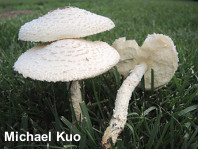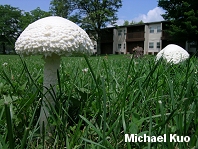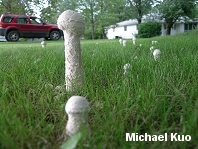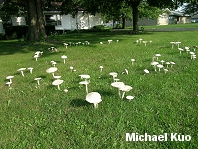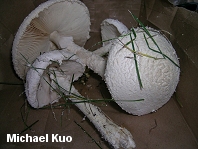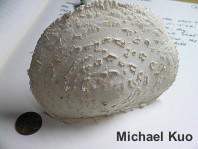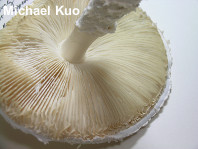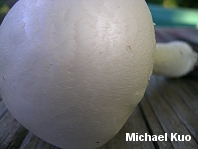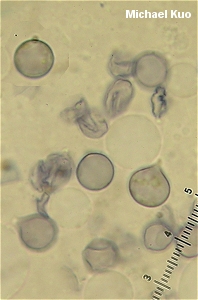| Major Groups > Gilled Mushrooms > Pale-Spored > Amanita > Amanita thiersii |

|
Amanita thiersii [ Basidiomycota > Agaricales > Amanitaceae > Amanita . . . ] by Michael Kuo Unlike most species of Amanita, which are mycorrhizal, Amanita thiersii is a saprobic decomposer of dead grass roots, and is not found in woods or in association with trees. From a distance, Amanita thiersii is easily confused with Chlorophyllum molybdites, a well known feature of summer lawns across North America. Unlike Chlorophyllum molybdites, however, Amanita thiersii has white gills at maturity—and it is covered from head to toe with shaggy, sticky universal veil material. Amanita thiersii was originally described from Texas (Thiers, 1957)—but the species has been expanding its range over the last few decades. In my area (central Illinois), it was rarely if ever seen 20 years ago; now it is a very common lawn ornament. It has made its first documented appearances in central Indiana over the last decade, and I have had photos of the species sent to me recently from southern Ohio and from Baltimore. The species appears to have a northern limit, perhaps associated with temperature, below the Great Lakes; it has not yet appeared in northern Illinois, even though Chicagoland is much closer to my area than Baltimore. Then again, prevailing winds here move from west to east, and if spore dispersal via wind currents is the mode of range expansion, this would provide an alternative explanation. Thiers (1957) originally named this species "Amanita alba," but was apparently unaware that the name was already in use; thus Bas (1969) was forced to change the name of the species in order to give it a legitimate name. Thanks to Ron Kerner for collecting, documenting, and preserving Amanita thiersii for study; his collection is deposited in The Herbarium of Michael Kuo. Description: Ecology: Saprobic in grasses; growing alone, scattered, gregariously, or in arcs and fairy rings in lawns and meadows; summer; south of the Great Lakes (see discussion above). The illustrated and described collections are from Indiana and Illinois. Cap: 3–15 cm; egg-shaped to convex at first, becoming broadly convex or nearly flat; soft; dry; covered with powdery, shaggy, universal veil material (sometimes washed away by rain) that comes off easily; white; the margin hung with veil remnants. Gills: Free from the stem or nearly so; close or nearly distant; short-gills frequent; white, maturing to slightly yellowish. Stem: 10–19 cm long; 1–2 cm wide; sturdy; equal above a very slightly enlarged base; with a skirtlike, white ring; bald above the ring; below the ring shaggy like the cap; volva powdery and indistinct; basal mycelium white. Flesh: White; soft; unchanging when sliced. Odor: Slightly foul. Chemical Reactions: KOH negative on cap surface. Spore Print: White. Microscopic Features: Spores 7–10 µm; globose; smooth; amyloid. Basidia 4-spored, without clamps. Lamellar trama bilateral; subhymenium cellular. REFERENCES: Bas, 1969. (Thiers, 1957 [A. alba]; Smith, Smith & Weber, 1979; Weber & Smith, 1985; Jenkins, 1986; Metzler & Metzler, 1992; Horn, Kay, & Abel, 1993; Kuo & Methven, 2010; Wolfe, Kuo & Pringle, 2012; Tulloss, 2013; Kuo & Methven, 2014.) Herb. Kuo 07280307, 07290301, 07220704, 09100701, 07190807, 07121601. This website contains no information about the edibility or toxicity of mushrooms. |
© MushroomExpert.Com |
|
Cite this page as: Kuo, M. (2016, August). Amanita thiersii. Retrieved from the MushroomExpert.Com Web site: http://www.mushroomexpert.com/amanita_thiersii.html |
